
In conducting research for last night’s post on the German housing market, I came across some interesting information on the housing bubble developing in Sweden. It’s a story worth sharing since it offers important insights and parallels for Australia.
Before I kick-off, first consider the below chart of real house prices since the mid-1980s:
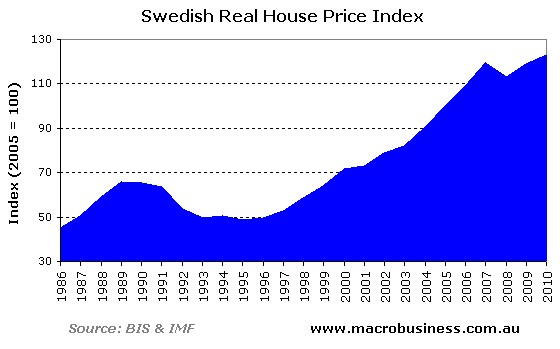
As you can see, Sweden has experienced two housing bubbles over the past 25 years:
- the late 1980s housing bubble, which came about after its financial system was deregulated in the mid-1980s and resulted in the early 1990s Swedish Banking Crisis after house prices crashed, as well as the bail-out of Sweden’s banks by the government; and
- the current housing bubble, which has gathered pace over the 2000s and is yet to burst.
Now consider the home ownership rate in Sweden, which appears to be broadly similar to other developed countries (chart courtesy of the IMF):
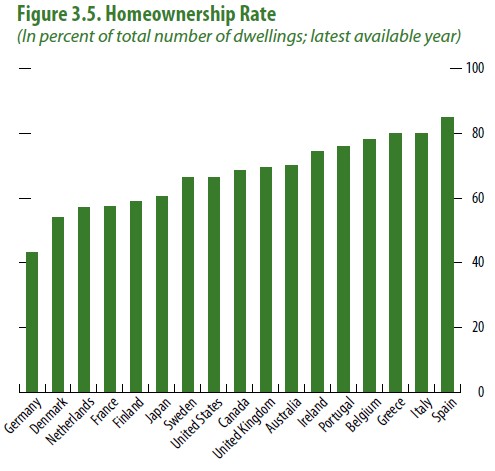
Like many other countries that have experienced housing bubbles, there appear to be two main causes of Sweden’s house price surge: constraints on housing supply caused largely by government policies; and demand-side drivers such as government stimulus and easy credit.
Supply-side squeeze:
According to the RICS 2011 European Housing Review, Sweden’s rate of new home building is amongst the lowest in Europe. Following the removal of generous subsidies and tax breaks, home building rates in Sweden collapsed from around 65,000 units annually in the early 1990s to around half that level throughout the 2000s (see below chart).
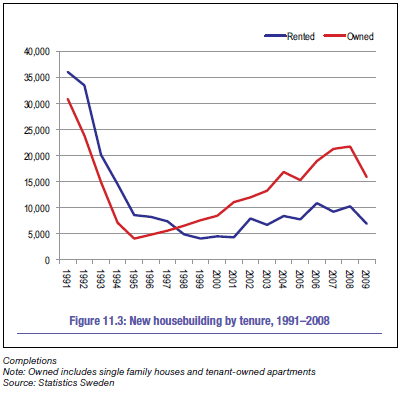
The supply situation in Sweden sounds worryingly similar to the dysfunctional and restrictive UK planning system described in my earlier post. According to RICS:
Housing construction costs are the highest in Europe, according to Eurostat, at around 55% above the EU average. The OECD attributes high house building costs to market structures that evolved in the era of high housing subsidies, limited competition, low levels of construction imports, and heavy regulations – all of which constrain competition and innovation.
Supply responsiveness is affected by land supply constraints. Land shortages occur for NIMBY reasons. Complex and lengthy processes of plan formulation and then appeals procedures generate considerable delay even where residential development is permitted. Furthermore, the structure of local authority finance discourages new development. Until the 2008 reforms, no local taxation was derived from property and municipalities still have large upfront costs, with little prospect of payback for many years to come, so the incentives still do not seem that positive.
Pumping demand:
On their own, Sweden’s supply constraints are bad enough. However, the government has compounded Sweden’s housing woes by operating policies that have stimulated substantial demand, thus guaranteeing strong price appreciation.
First and foremost, the Swedish tax system encourages house purchase over other investment options. In general, owner occupiers can deduct 30% of mortgage interest from their marginal rate of tax. Although there is also a capital gains tax of 30% on two-thirds of any price rises, this can be deferred as long as another owner occupied property is bought, and the rule applies to heirs as well.
A wealth tax was abolished in 2008 as was a national real estate tax, to be replaced by a lower municipal property fee. Overall, recent tax changes have helped to sustain the buoyancy of Swedish house prices.
Second, access to mortgage credit has been particularly loose in Sweden. In the years leading up to the Global Financial Crisis (GFC), loans were typically granted up to 95% of property value, although 100% plus loans were also available. Moreover, loan amortisation periods are particularly long in Sweden – at 100 years for houses and 200 years for tenant-owner apartments. Recently, however, the Government has moved to cap mortgage loan-to-value ratios (LVRs) at 85%, although additional unsecured funding can still be obtained at higher interest rates .
The combination of the above factors has encouraged Swedes to maintain high levels of gearing, as shown by the below IMF chart:
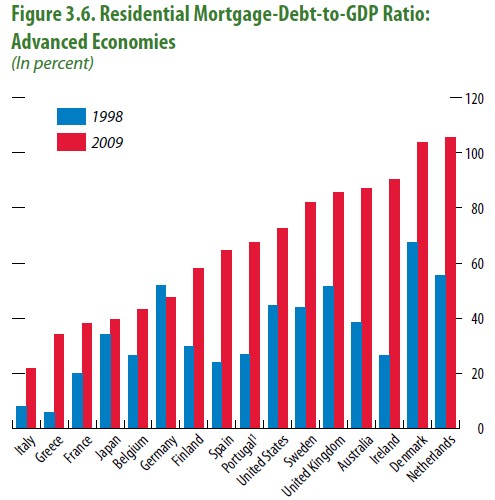
Finally, like in Australia, the Swedish authorities implemented a range of measures to stimulate the housing market and maintain the flow of mortgage credit during the onset of the GFC.
Tax breaks were implemented in 2008 for homeowners wishing to renovate newly purchased properties. The government also stepped-up the provision of liquidity to the banking sector, guaranteeing the funding of the banks and mortgage institutions, as well as establishing a long-term stability fund to deal with any future solvency problems.
The Central Bank also dropped official interest rates, resulting in a sharp fall in mortgage rates (see below RICS chart).
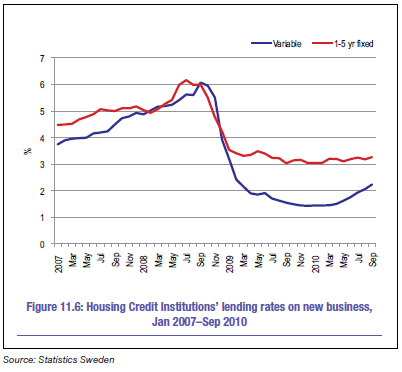
These measures combined ensured that Swedish mortgage growth maintained a solid pace throughout the GFC, thus underpinning home values (see below RICS chart).
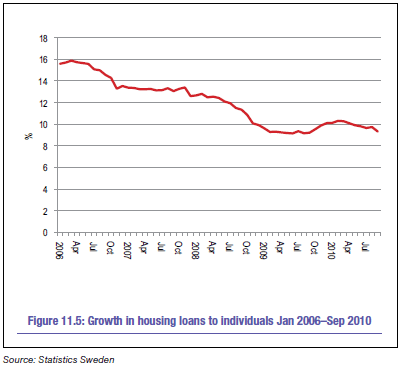
Consequences:
As summarised beautifully by RICS, Sweden’s housing policies have had a pernicious effect on the young and disadvantaged:
The distribution of housing opportunities favours incumbent households over newly- or recently-formed ones and others wishing to move particularly into, and within, places where economic growth is strong. In other words, it is a system where lucky ‘insiders’ gain at the considerable expense of ‘outsiders’. This not only creates unintended social consequences but also imposes significant economic costs. Added to the cocktail is a political scene with recent closely fought elections, which have encouraged governments to cut property taxes and to put housing market reforms on the back burner.
Owner occupation has become the sole option for housing aspirations of many in a situation of constrained supply. This has encouraged a long trend of higher prices, which have generated wealth gains for some… and, so, has led to types of inequalities that the original interventions were supposed to smooth out.
The Swedish economy is now at risk of a severe housing downturn. The overwhelming majority of Swedish mortgages are variable rate (see below chart), meaning that home prices would likely come under severe pressure if/when interest rates increase from their current low settings.
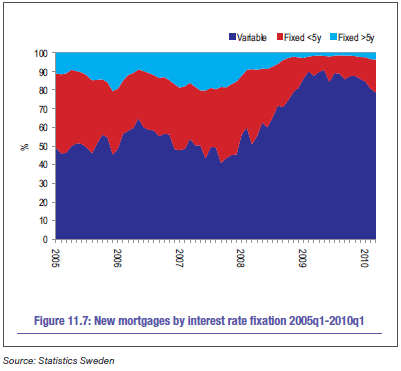
Sweden’s National Housing Credit Guarantee Board (BKN) – a government agency responsible for administering government credit guarantee programmes for housing development – earlier this year warned that home prices are severely overvalued and risk correcting once interest rates normalise:
“We have had a bubble for the past two years and it will deepen as the interest rates rise. When we return to normal interest rate levels of around 5.5 percent, it will start to become noticeable,” said Bengt Hansson at BKN told The Local on Wednesday…
“Real house prices are still high in a historical perspective and there is much to indicate that house prices are to a great extent held up by artificial monetary policy-driven low interest rates,” BKN wrote in its report.
Several observers shared BKN’s view that mortgage interest rates will soon climb to 5.5 percent, but despite the interest rate progression BKN is concerned that household debt continues to accumulate at a rapid pace.
“Based on the fundamentals – such as income development and other factors – house prices are at unsustainable levels. We estimate that prices are around 20 percent above what they should be,” Bengt Hansson said…
BKN concludes in its international comparison that in several countries which have suffered dramatic house price falls, invested capital has all but disappeared, removing the scope for loan-fuelled consumption along with it.
According to BKN, Sweden’s situation is similar and the current market conditions fulfil the criteria for rapid growth in debt, arguing that this is in itself is a contributing factor for a crash in the housing market…
The actual amortization periods for new Swedish home loans is now about 100 years for houses and nearly 200 years for tenant-owner apartments.
“This means that we believe that we don’t need to pay off our house purchase. It is naive to believe that house prices can rise indefinitely,” Bengt Hansson concluded.
Looks like another dead bubble walking to me…

